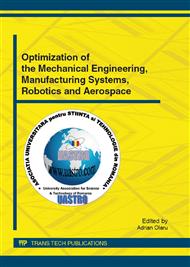p.254
p.260
p.266
p.273
p.280
p.291
p.297
p.305
p.310
Development and Optimization of Perimeter Traversing Robot
Abstract:
This paper presents the development and optimization of control parameters of an autonomous robot capable of traversing a planar surface without going beyond the surface boundary. Based on standard Lego® design, the proposed robot travels on surfaces with different geometrical shapes and collects data on the basis of which the perimeter can be redrawn using MATLAB. The remote detection capabilities of this robot can find its application in construction, defence surveillance operations, geological and space research and industry as an automated process of measurement, especially when the surface being measured is beyond human reach. The robot detects the edge using a color sensor which differentiates the color of the surface from its boundary. After detecting an edge point, the robot retracts and turns to detect an edge point in another direction. The length of the paths traversed by the robot from one edge point to another serves as the input data to the MATLAB program which computes this data and transforms it to a plot of the perimeter. Experiments conducted demonstrate the optimal values of parameters for control of motion of the robot to give satisfactory results with minimal power and time expenditure.
Info:
Periodical:
Pages:
280-288
Citation:
Online since:
June 2012
Keywords:
Price:
Сopyright:
© 2012 Trans Tech Publications Ltd. All Rights Reserved
Share:
Citation:


